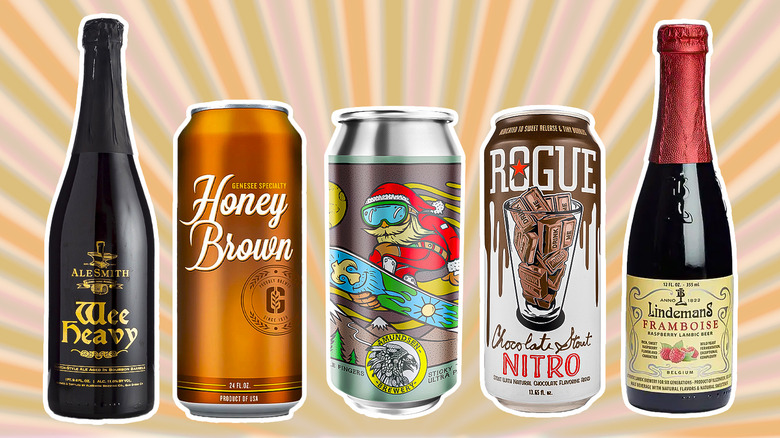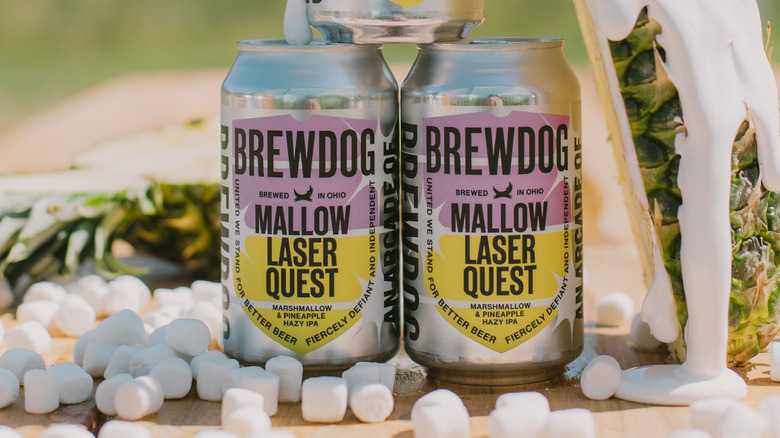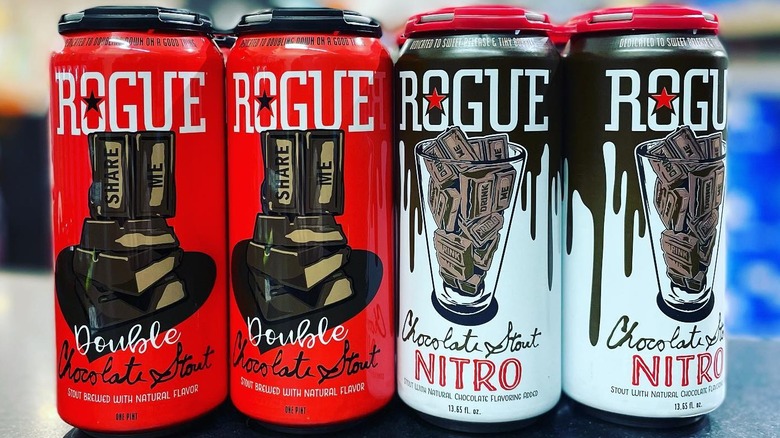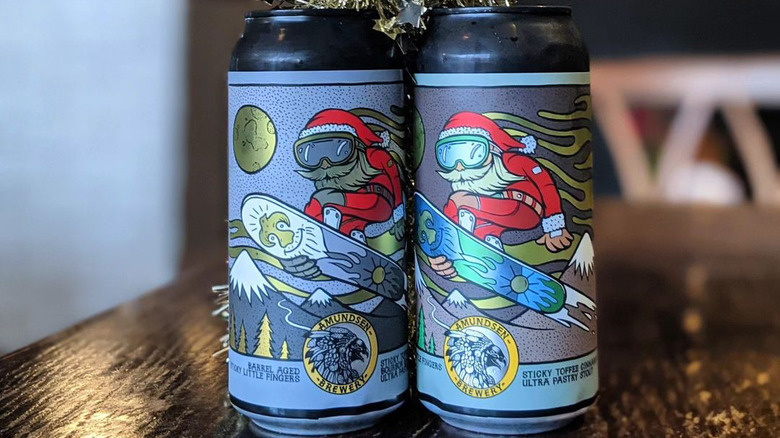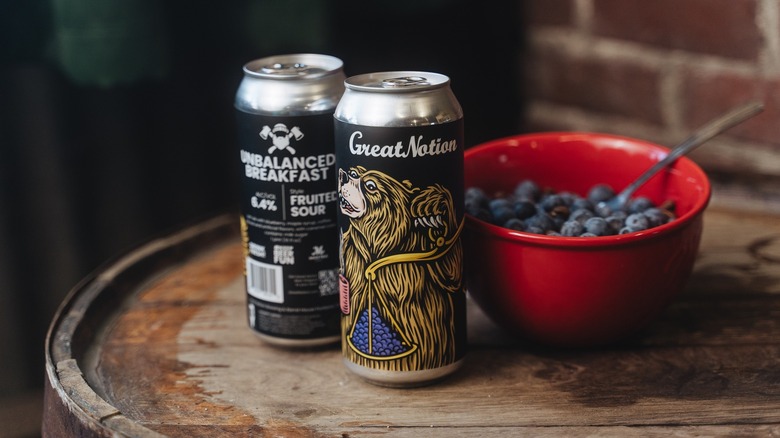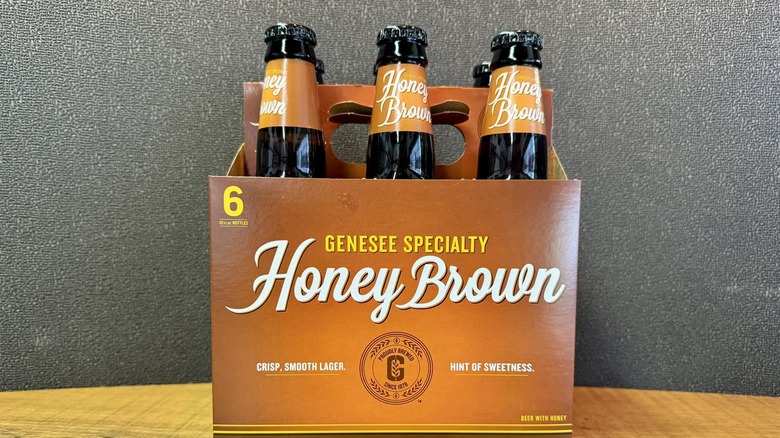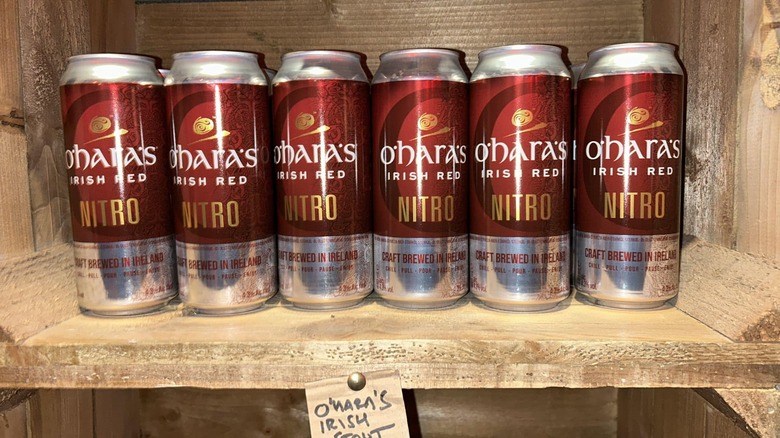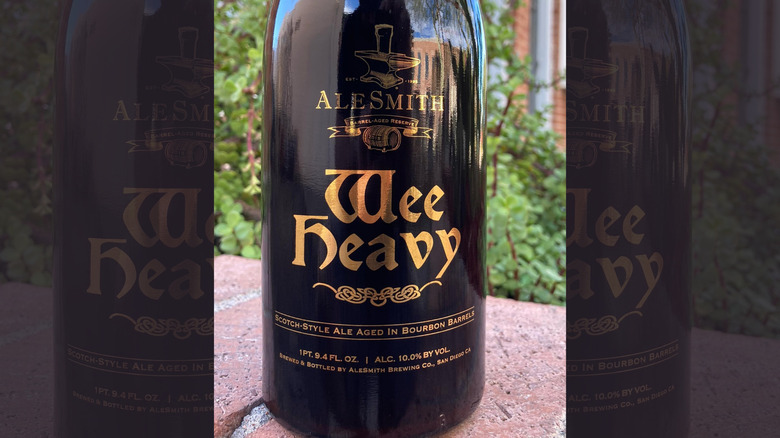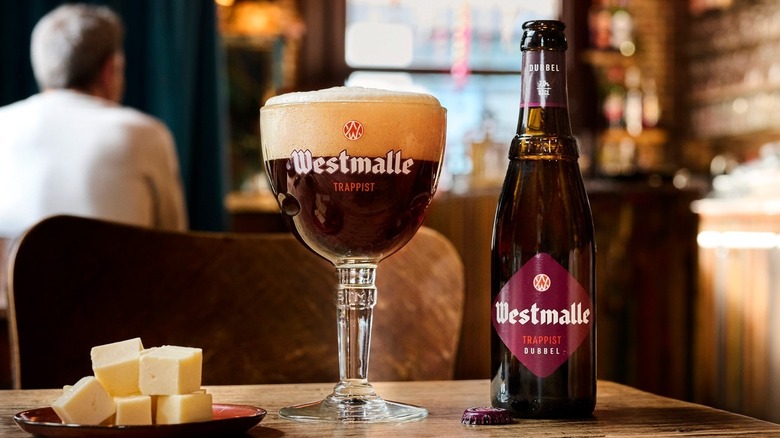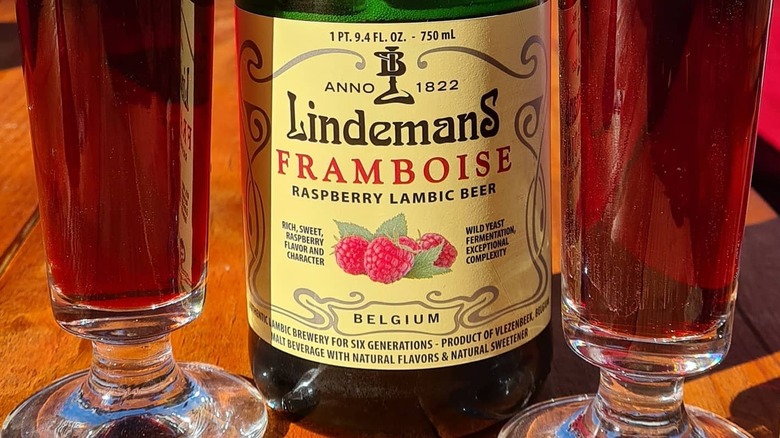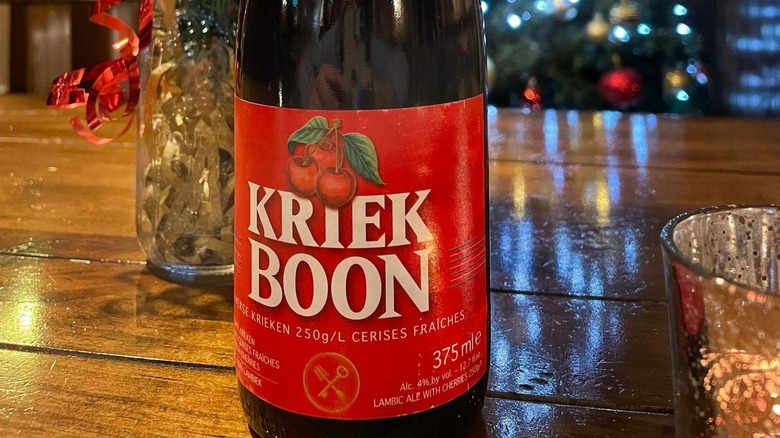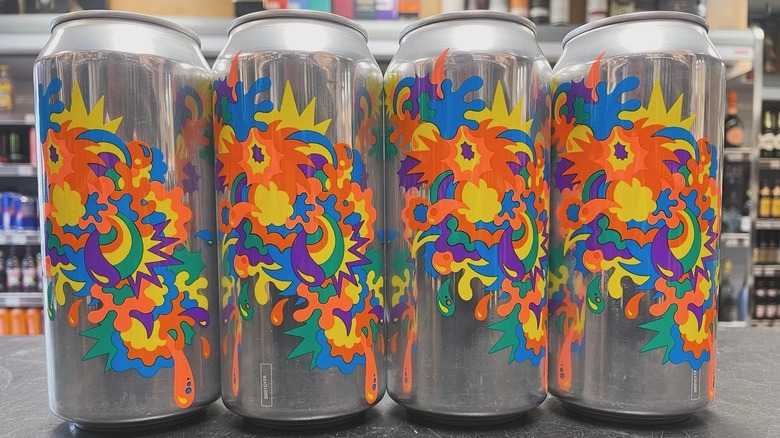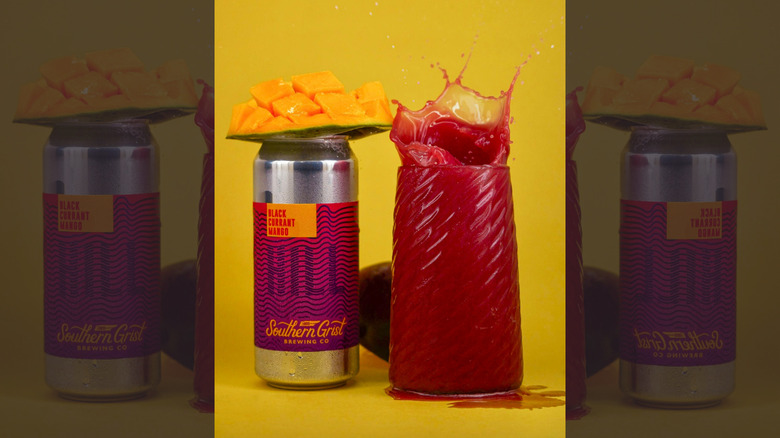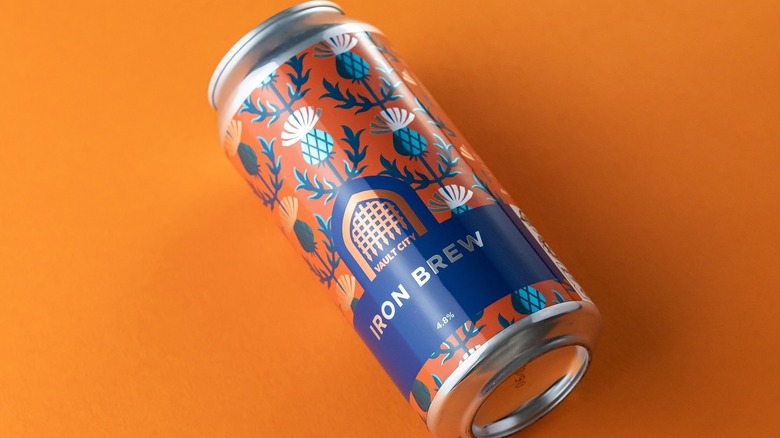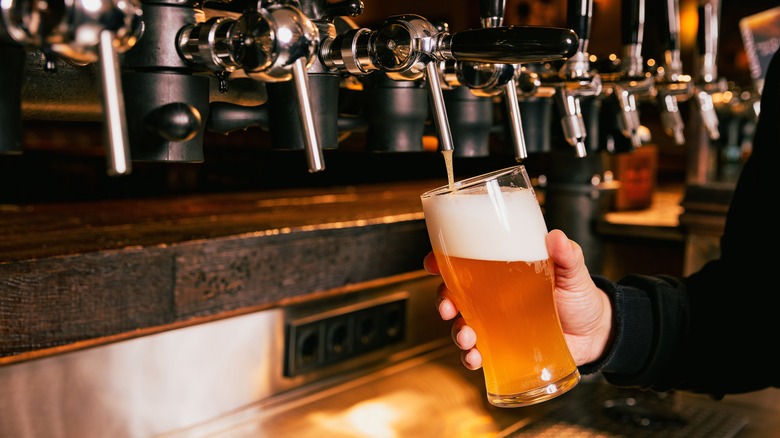13 Absolute Best Beers To Satisfy Your Sweet Tooth
One of my favorite things about beer is the incredible amount of diversity across the different styles. However, throughout my time managing craft beer bars and running beer schools, I've noticed something about how people perceive the flavor of beer. We often talk about it being bitter, malty, or hoppy, but we don't discuss sweetness very much.
To put the following beer choices in context, it's worth knowing what makes a beer sweet, and how flavor profiles of sweet beer are a little more complex than many people realize. Some beers are labeled as "dry" — meaning not sweet — but most beers contain no added sugar. The sugar in brews usually comes from malted barley, and it's eaten by yeast to produce alcohol through fermentation. Some brewers even use special malts that give beer a caramel-like flavor. Occasionally, fermentation is halted before all the sugar has been consumed, which can make a beer taste sweeter. This is how sugar impacts a beer's alcohol by volume (ABV), and why strong beers typically start with more sugar in them and are fermented for longer.
Some brewers add fruit for flavoring, or sugars that cannot be fermented (like lactose), which increases a beer's sweetness and imparts a creamier mouthfeel. It's also common for sour beers to have sweet aspects thanks to such additions. So, although the following beers will satisfy your sweet tooth, a great beer is well-balanced, and these selections may also be sour, bitter, fruity, roasty, or malty.
BrewDog's Mallow Laser Quest
The craft beer movement began in Britain at approximately the same time when it got started in the United States, around the 1970s. However, I think it would be fair to say that the true craft beer revolution began in 2007, when the Scottish brewer, BrewDog, launched its American IPA-inspired Punk IPA.
By the time I was employed by BrewDog to run one of its brewpubs in 2021, it had become a globally recognized craft brewer, notorious for inventive beers and unorthodox marketing. Some of its more creative brews fell short, and Mallow Laser Quest — a marshmallow and pineapple hazy IPA — was a beer that many of us thought would be a failed gimmick.
As it turned out, it was one of the most popular beers I ever put on tap. With flavors of marshmallow, candied pineapple, and sherbet, Mallow Laser Quest is surprisingly well-balanced. There's very little bitterness, but the sweeter ingredients are tempered with prominent citrus from the bold hops. The pineapple adds a fruity, tropical dimension, enhanced by plenty of creamy vanilla from the marshmallow. It's also worth noting that although this beer is frequently referred to as a milkshake IPA, it doesn't contain lactose, so it's suitable for vegans and those with dairy intolerances.
Rogue's Chocolate Stout Nitro
I first encountered Rogue before craft beer had really taken off in the U.K. — in fact, I believe this brewery made the first American-style IPA that I ever tasted. It's one of the stalwarts of the American craft beer movement, and it has been making award-winning beer since 1988.
Rogue doesn't have a massive international presence, so it dropped off my radar until I was fortunate enough to visit the Oregon coast this year. After somehow managing to score a tour of its brewing facility — where I was on my best behavior while diligently avoiding common mistakes when visiting a brewery — I tried some of its stellar beers in the taproom.
I was particularly impressed with the stouts, a style that tends to have a natural sweetness balancing out the roasty notes. The Shakespeare Stout is admittedly my favorite if I'm after a more classic flavor, but the extra creamy, nitrogen-infused Chocolate Stout is a stunning dessert-style beer. Made with real chocolate, it has some noticeable hop bitterness, but also a dash of smooth caramel. If you want it even more chocolatey and don't mind the sweetness dropping a tad, Rogue also makes a boozy, decadent, imperial version of this beer.
Amundsen's Sticky Little Fingers
Despite being the largest brewery in the Norwegian capital of Oslo, Amundsen doesn't churn out gallons of mass-produced, ordinary beer. It's known for its boundless creativity, especially when it comes to dessert beers.
Although Amundsen offers an extensive "Dessert in a Can" lineup, my personal favorite of its sweet-treat beers doesn't technically fall into that series. Sticky Little Fingers is labeled as a toffee-tasting pastry stout inspired by cinnamon buns, and if that doesn't have you salivating, I don't know what will. A fair warning though — this beer comes in at a whopping 12.5% ABV, with a strength and flavor that isn't for the faint of heart.
Sticky Little Fingers is decadence in a can. It's extremely rich and viscous, with oodles of chocolate and vanilla, and an aroma of sticky toffee pudding with touches of cinnamon. Despite its sweetness, there's no added lactose, so it's suitable for vegans and for those with dairy intolerances. My main advice is that if you end up buying a can, split it among friends, as it's a beer best enjoyed in smaller quantities.
Great Notion's Unbalanced Breakfast
By the time I started managing a BrewDog bar, I was pretty well-versed in craft beer. I'd tried plenty of styles from around the world, from IPAs to sours — but Great Notion's Unbalanced Breakfast was the beer that showed me that I'd only started to scratch the surface of what was possible.
Based in Portland, Oregon, Great Notion isn't afraid to try their hand at any style of beer, but the fruited sours have to be tried to be believed. Unbalanced Breakfast is essentially like drinking liquified blueberry pancakes drizzled in maple syrup. Aside from being made with real blueberries and syrup, Great Notion also adds whole bean Mostra coffee to the brew, which gives the beer a wonderfully rich finish.
The slight bitterness of the coffee helps to round out the sweetness of the added ingredients, which includes lactose for an extra-creamy mouthfeel. As a sour-style beer, Unbalanced Breakfast does have a tartness to it, but it's not overpowering. It's also devoid of any funky or vinegary flavors that are typical of some sour beer styles.
Genesee's Specialty Honey Brown
Genessee — based in Rochester, New York — is one of the oldest breweries in the United States. While the company does have a reasonably varied range, they're not considered to be an "out there" craft brewer that whips up strange or unusual beers.
Out of all the beers on this list, Honey Brown is probably the most run-of-the-mill, but that's not a bad thing. Not everybody likes quaffing double dry-hopped IPAs or imperial oyster stouts. Despite having "brown" in the name, Honey Brown is more of a golden-to-amber lager. At 4.5% ABV, it's a clean, easy-drinking beer that won't overwhelm the palate. However, that doesn't mean it's akin to those insipid, mass-produced products like Coors or Bud Light.
Honey Brown strikes the perfect balance, with caramel malt flavors and a gentle hop bitterness. The added honey is noticeable but never cloying, and it doesn't mask the lager's more nuanced tasting notes. If you prefer a sweeter beer that's unique yet comfortingly familiar, Honey Brown is the way to go.
O'Hara's Irish Red
If you prefer ales to lagers but like sweeter beers over bitter beasts, the Irish red style is one to look out for. Originating from — you guessed it — Ireland, these beers are technically a type of pale ale.
The sweet characteristics of Irish red ales are mostly due to the type of specialty malts added to the recipe. Crystal malts are usually kilned for longer than the base malts, which helps caramelize their sugars. This helps imbue the beer with flavors of rich toffee while contributing to its bold red coloring.
Out of all the Irish reds available, I find O'Hara's to be the best showcase of the style. It's big on malt sweetness, with a very mild bitterness. There are some gorgeous nutty flavors and biscuity malt notes too, making it a great beer for pairing with hearty winter meals. O'Hara's Irish Red is also a good choice if you like some of the richer qualities of a stout but find black beers too roasty or intense.
AleSmith's Barrel-Aged Wee Heavy
Also referred to as Scotch ale (although I think we can agree which name is better), the beer called wee heavy is the sweeter, bolder cousin of the Irish red. Hailing from Scotland, wee heavies are generally stronger, richer, and more full-bodied.
Wee heavies tend to feature a wider range of specialty malts, which produces flavors of dark fruits as well as toffee and caramel. Longer boil times also help some of these deeper malt notes develop, and there's often residual sugar left over in stronger brews, which boosts the sweetness. I'm a big fan of the wee heavy, especially those that use peated malts to give the beer something of a Scotch whisky quality — but AleSmith's Barrel-Aged Wee Heavy is arguably the best of its class.
With this brew, AleSmith demonstrates how used bourbon barrels can impact the flavor of beer, infusing the liquid with heaps of complementary flavors that launch its malt complexity into orbit. You end up getting more dark fruit notes along with vanilla, oak, and a touch of tobacco. The mouthfeel is incredibly heavy and smooth — just shy of syrupy — and there's a boozy, almost rum-like sweetness that runs across the palate.
Westmalle's Trappist Dubbel
When I first started expanding my beery horizons, I tended to avoid Belgian styles, probably out of sheer intimidation. There are many types of Belgian beer, and they vary so dramatically in terms of strength and flavor that it can be difficult knowing where the access point is. For me, it was Westmalle Trappist Dubbel.
Dubbels are a Belgian beer style that has some similarities to the wee heavy, notably the fact they use a combination of light and dark malts to produce a rich, malt-forward beer of higher-than-average strength. However, they also make use of Belgian yeast, which produces fruity and spicy notes in the beer. This adds flavors like banana, apple, pepper, and clove that meld perfectly with its sweet caramel qualities. Dubbels also sometimes include added sugar, which acts as fuel for the yeast and boosts the alcohol content.
Westmalle's Dubbel is arguably the most traditional expression of the style, which has a history dating back centuries and was revived in the 19th century. The Trappist beer moniker refers to monks that have been making beer as far back as the Middle Ages, so beers created by Trappist breweries have no shortage of experience.
Lindemans' Framboise
Lambic beers are another Belgian style, although they can be hard to sell to someone who's never tried one before. For starters, the production method used for creating this type of sour beer is a little unorthodox.
Lambics undergo a process called spontaneous fermentation. Instead of using specially cultivated brewer's yeasts, the unfermented beer is left exposed to air in long troughs. This allows wild yeasts to contaminate the beer, as well as certain bacteria. These microorganisms are completely harmless, but they're responsible for the sour flavors of the beer, as well as earthy and funky characteristics. It's no secret that lambic beers can be an acquired taste — it took me a little while to fall in love with them — but fruited lambics are a highly approachable gateway style.
Lindemans has been brewing lambics for some 200 years, and its low-ABV, fruit-infused sours are unbeatably refreshing. Lindemans Framboise — from the French for "raspberry" — is infused with heaps of real raspberries, making it perfect for a dessert pairing or as a summer sipper. It's not especially funky, either, and has a dry finish that tempers the sweet fruit and gives it a champagne-like quality.
Boon's Kriek Boon
Like a framboise, kriek is another type of fruity, sweet, and approachable lambic beer. However, "kriek" is Flemish for "cherry," so this brew is packed with cherries instead of raspberries.
Cherries are an incredible fruit for lambics, having a natural tartness that complements the style, but with plenty of sweet, dark-fruit character. There are many fantastic cherry lambics out there, although they vary dramatically in terms of price and availability. My personal all-time favorite is Spontan Cherry Frederiksdal from the Danish brewery Mikkeller, but this can be a bit tricky to source. However, if I'm getting a craving for a sweet-and-sour cherry lambic, Boon's Kriek Boon is always a reliable substitute.
Kriek Boon's recipe features no less than a whopping 250 grams of real cherries per liter of beer, giving it a stunning ruby-red hue and a massively fruity profile. It's light and balanced with a nice complexity, thanks to the fact it's made by combining both young and aged lambic beer. It also has great natural carbonation, thanks to a process called secondary fermentation. This is a technique that's also used in champagne production, when the beer continues to ferment after bottling as the yeast keeps munching on residual sugars.
Omnipollo x Burley Oak's Bianca J.R.E.A.M.
While Stockholm might not appear on a typical list of cities in Europe that every beer lover should visit, the Swedish capital is home to one of the world's most innovative microbreweries. Omnipollo started as a joint venture between a brewer and a graphic artist who were determined to express beer-making as an elevated art form.
Omnipollo's iconic cans contain liquids that push the boundaries of what beer can be, and Bianca J.R.E.A.M. is a brew that exemplifies this. The beer's full name is as much of a mouthful as the drink itself — Bianca J.R.E.A.M Blueberry Lime Pecan Cobbler Lassi Gose. For the uninitiated, a gose is a sour-style German wheat beer with a lemony tartness, and it typically includes coriander and salt in the recipe. Most gose beers wouldn't be considered sweet, but this fruited version — a collaborative effort with Maryland's Burley Oak Brewing Company — is more like drinking a tropical smoothie than a beer. The beer's sour qualities perfectly temper the fruit sweetness, and the pecans complement a delicious pie-crust character.
Southern Grist's Black Currant Mango Hill
Based in Nashville, Tennessee, Southern Grist Brewing Co. is another one of those breweries that make it hard to choose a favorite beer. While its range includes more typical craft styles, Southern Grist's numerous sweet series are unmatched if you're a dessert-beer lover.
There's a Melted Sno Cone range of fruited sours, an Upside Down Cake series of juicy milkshake IPAs, and even a selection of coconut-based milk stouts. But if you love a juicy, smoothie-like beer, the Hill range is where it's at. These lactose sour ales are super thick and include heaps of real fruit puree for that unbeatable authentic flavor.
My personal pick is the Black Currant Mango Hill — mostly due to the fact that it blends my two favorite fruits — but the range is far from lacking in variety. Southern Grist has strawberry beers, pineapple beers, cranberry beers — if you can think of a fruit, there's a strong chance this brewery has brewed with it. Plus, if you prefer a stronger drink, there are also imperial versions available for many of their products.
Vault City's Iron Brew
The very first beer I tried from Edinburgh's Vault City brewery was its Blueberry Pumpkin Spice Latte. I was blown away by the fact that it tasted exactly like I hoped it would, even though I didn't expect it to live up to its name.
I stocked Vault City beers at my bar as often as I could, partly because my staff couldn't get enough of them. It was also because they astounded customers who weren't beer fans and didn't realize how diverse beer could truly be. The use of real fruit results in incredibly smooth, thick beers — in fact, I even had to adjust my cellar system at times, just to get the beer through the lines. I knew when I started writing this article that I was going to feature Vault City, but choosing the brewery's "best beer" is nearly impossible, because they're all so good.
That said, I'm going to highlight Iron Brew. This beer is Vault City's take on Scotland's favorite soft drink, Irn-Bru. It's so popular up there that Scotland is said to be one of the only countries in the world where Coca-Cola isn't the best-selling soft drink. Part of what makes it so interesting is that Irn-Bru's flavor is notoriously indescribable, but Vault City manages to replicate it perfectly. Personally, I feel that "lemony bubblegum" is the best description, but it's more fun to pick up a can and try and identify the nuanced flavors yourself.
Methodology
When choosing the beers for this article, I wanted to highlight as many styles as possible that have the potential to taste sweet. This is why I decided not to stick with beers that are predominantly sweet, with all their other flavors muted — just because someone has a sweet tooth, that doesn't mean they don't have a complex palate. Additionally, I wanted to showcase beers that are sweet for different reasons, whether it's due to added ingredients, residual sugar left over from fermentation, or the type of malt used.
The products above are all beers that I've tried personally. The majority of them are products that I ordered or imported to sell at the craft beer bar I managed, so I can vouch for their quality and popularity. I've also been lucky enough to tour two of the listed breweries. Thanks to my Cicerone training — the beer equivalent of learning to become a wine sommelier — I've got plenty of experience with the history and brewing processes of the specific styles.
